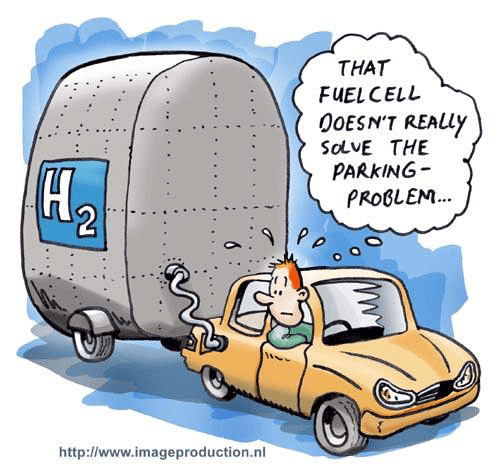In response to my article on hydrogen fuel cells, one of my readers, John V. Ryan, has written a follow-up article about the comparison between Battery Electric Vehicles (BEV’s) and Hydrogen Fuel Cell Vehicles (HFCV’s). Hopefully, this inspires others to do the same, so we can build this site into a platform where everybody can write or blog about their view on the automotive industry. Thanks John! Bart.
Hydrogen Fuel Cell Vehicles compared to EV’s
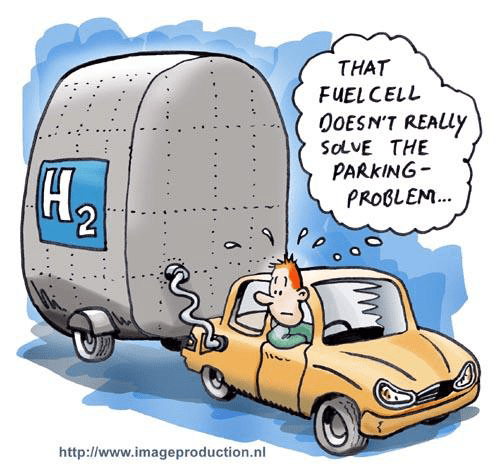 Regarding automobiles, it appears Battery Electric Vehicles (BEV’s) are superior at this time to Hydrogen Fuel Cell Vehicles (HFCV’s), and will remain so for the foreseeable future, for three reasons:
Regarding automobiles, it appears Battery Electric Vehicles (BEV’s) are superior at this time to Hydrogen Fuel Cell Vehicles (HFCV’s), and will remain so for the foreseeable future, for three reasons:
- HFCV’s offer less than 1/3 the efficiency of BEV’s.
- Mobile hydrogen fuel cells (HFC’s) are not yet even being manufactured, let alone near reaching economies of scale. In contrast, mobile Li-ion batteries are well-developed and dropping in cost: they have become 40 to 50% cheaper in the past two years alone – and many private and public groups are working intensely to create even better mobile batteries.
- Creation of the hydrogen refueling infrastructure will be epic, and cost many billions of dollars. Meanwhile, electricity is available everywhere, and, happily, BEV’s mostly recharge during off-peak hours, utilizing power that would otherwise be wasted. Where required, electrical grid capacity upgrades are relatively inexpensive, and easily accommodated. Even better, within a smart grid, BEV’s add the benefit of becoming dynamic storage devices, allowing the electrical utility to “borrow” power from them at peak times, and then pay it back at off-peak times.
A transportation system based on HFCV’s seems, at first thought, like a great idea: Clean and efficient, right? The Federal Government has been funding research and development of HFCV’s, and the requisite refueling infrastructure, for decades. GM has done tons of work, and Honda has had a car, the FCX Clarity, on the road since 2008.
Big investments in Hydrogen Fuel Cells
Other automakers working on HFCV’s include Daimler AG, Honda, Hyundai and Toyota. Although Ford and Renault-Nissan cancelled their hydrogen car R&D efforts in 2008 and 2009, respectively, they signed a 2009 letter of intent with the other manufacturers in September 2009 – supporting the commercial introduction of HFCV’s by 2015. This suggests big R&D support for HFCV’s, huh?
 Right now, Honda has approximately 25 leased cars at any one time in the hands of owners in LA where a group of hydrogen filling stations is open 24/7. The article titled Test Drive: Honda FCX Clarity is fuel-cell fab is a forward-looking report from July, 2013. The article tells us that Honda plans to introduce a second-generation “fuel-cell car in 2015, the year that automakers have decided they will begin to commercialize hydrogen machines – at least in California, where there are publicly accessible fuel stations”. The plan is to have about 68 fuel stations around that time. A hydrogen fuel station has come way down in cost and construction time: They now cost ~$1 million, and take two years to build. I wish them good luck.
Right now, Honda has approximately 25 leased cars at any one time in the hands of owners in LA where a group of hydrogen filling stations is open 24/7. The article titled Test Drive: Honda FCX Clarity is fuel-cell fab is a forward-looking report from July, 2013. The article tells us that Honda plans to introduce a second-generation “fuel-cell car in 2015, the year that automakers have decided they will begin to commercialize hydrogen machines – at least in California, where there are publicly accessible fuel stations”. The plan is to have about 68 fuel stations around that time. A hydrogen fuel station has come way down in cost and construction time: They now cost ~$1 million, and take two years to build. I wish them good luck.
Efficiency comparison
Unfortunately, at this point, we have invested perhaps 30 years and billions of dollars trying to create a hydrogen economy, yet we’re far from implementation. The article Why a hydrogen economy doesn’t make sense was published back on 12/11/2006. I find it’s a good read – in fact, it’s an indispensable slam-dunk-clear analysis of HFC’s. I found it quoted in articles less than two years old; it’s sorta’ damning that things haven’t really changed much in seven years.
Many of us harbor a fuzzy understanding of HFC’s. I used to picture a clean little box (white plastic, light green top, per my mental image) that somehow propelled one’s vehicle (maybe an electric motor was in there somewhere) and only put out a little water as we rolled along in silence. Yup, water, just a little stream of water. You could drink it. Magical.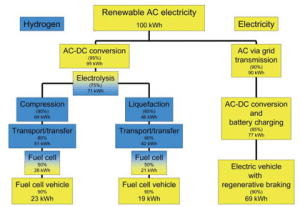
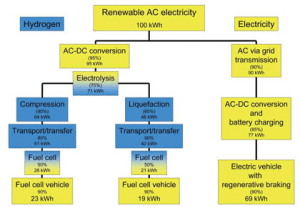 The truth is that an HFC doesn’t MAKE energy, it’s just a medium, a carrier of an electric charge, just like a battery. A much less efficient battery.
The truth is that an HFC doesn’t MAKE energy, it’s just a medium, a carrier of an electric charge, just like a battery. A much less efficient battery.
The article makes this salient point in a nice chart right at the beginning. Per the chart, given a 100 kWh power source, and an HFC or battery to power your EV, the amount of energy available to the motor will be
- Compression* fuel cell vehicle — 23 kWh
- Liquefaction* fuel cell vehicle — 19 kWh
- BEV’s w/regenerative brakes — 69 kWh
*Compression and liquefaction are the two methods by which hydrogen is concentrated for storage.
So, a BEV is 3-4 times more efficient than a HFC. Could this be a problem for HFCV’s?!
The article explains: “In a recent study, fuel cell expert Ulf Bossel explains that a hydrogen economy is a wasteful economy. The large amount of energy required to isolate hydrogen from natural compounds (water, natural gas, biomass), package the light gas by compression or liquefaction, transfer the energy carrier to the user, plus the energy lost when it is converted to useful electricity with fuel cells, leaves around 25% for practical use — an unacceptable value to run an economy in a sustainable future. Only niche applications like submarines and spacecraft might use hydrogen.”
“‘More energy is needed to isolate hydrogen from natural compounds than can ever be recovered from its use’, Bossel explains.”
“While scientists from around the world have been piecing together the technology, Bossel has taken a broader look at how realistic the use of hydrogen for carrying energy would be. His overall energy analysis of a hydrogen economy demonstrates that high energy losses inevitably resulting from the laws of physics mean that a hydrogen economy will never make sense.”
Do we really want to spend 10-20 MORE years, and billions of dollars to create the vehicles and build out a hydrogen infrastructure?
Infrastructure of hydrogen fuel stations
The infrastructure for EV’s is already ubiquitous, and only needs small incremental upgrades to handle EV’s, per Southern California Edison (SCE). On 8/6/13, SCE published a white paper, Charged Up: Southern California Edison’s Key Learnings about Electric Vehicles, Customers and Grid Reliability. The white paper tells us that, during 20 years of hosting the biggest colony of EV’s in the country, EV charging has added only 1% to SCE’s circuit upgrade workload. EV’s typically charge at night. This symbiosis eliminates the need to greatly expand peak (daytime) capacity, and captures a huge amount of energy that is currently wasted. The symbiosis extends further, as EV charging can give utilities a new power source to deal with transient peak demands. With SCE’s smart grid, EV’s add the benefit of becoming dynamic storage devices, allowing SCE to “borrow” power from them at peak times, and then pay it back at off-peak times.
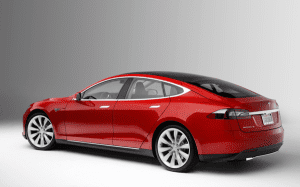
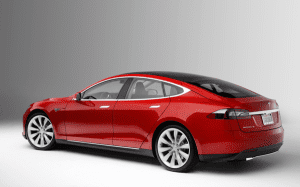 Martin Eberhard is a Tesla Motors co-founder and the company’s first CEO. Marc Tarpenning is a Tesla co-founder and the company’s first CFO. According to Tesla Motors: How it All Began, long before there was a company, “As Martin Eberhard and his friend Marc Tarpenning explored this (ecological cars like Priuses), they even looked at celluosic ethanol and hydrogen fuel cells before ultimately deciding to work on the electric car”. Their very quantitative analysis made it clear that EV’s greatly outdistanced fuel cell vehicles. Heck, it moved them to start an EV company. Their work is neatly captured in The 21st Century Electric Car.
Martin Eberhard is a Tesla Motors co-founder and the company’s first CEO. Marc Tarpenning is a Tesla co-founder and the company’s first CFO. According to Tesla Motors: How it All Began, long before there was a company, “As Martin Eberhard and his friend Marc Tarpenning explored this (ecological cars like Priuses), they even looked at celluosic ethanol and hydrogen fuel cells before ultimately deciding to work on the electric car”. Their very quantitative analysis made it clear that EV’s greatly outdistanced fuel cell vehicles. Heck, it moved them to start an EV company. Their work is neatly captured in The 21st Century Electric Car.
An Internet search will turn up many more studies of fuel cell technology and viability that suggest EV’s are superior. In particular, Wikipedia offers a good primer under Hydrogen vehicle and Hydrogen economy. The Wikipedia article Fuel cell has an “Automobiles” section that specifically addresses HFC’s in cars. Quoting several solid additional references, it arrives at the same conclusion – BEV’s are superior to HFCV’s – as stated here. The article suggests to me that there are two good mobile applications of HFC’s: Buses and forklifts.

